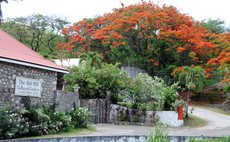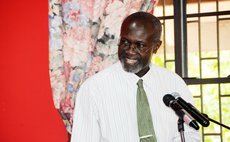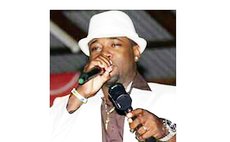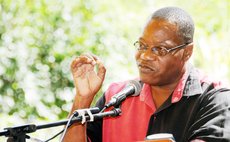Heritage of the Kalinago people
Yes, indeed the chant "Columbus lie" has been immortalized in Calypso by Shadow and Burning Spear who maintained that Europeans were unable to conquer the fierce resistance of the Kalinago. We were all taught, as children of the 50s -70s, that the Caribs were warlike and this stigma has followed them ever since. However, through documentation and magazines which highlight the heritage of the Kalinago a refreshing picture is revealed.
Volume II of the magazine "HERITAGE of the Kalinago People" was recently launched during the official opening of DOMFESTA; the magazine contains contributions from Cozier Frederick, Senior Cultural Officer Gregory Rabess, Gerald Langlais, Miranda Langlais, Marianna Stoute, former educator, retired politician and cricket historian Francois Barrie, cultural elder Prosper Paris- all Following messages from parliamentary representative and Minister for Kalinago Affairs- Casius Darroux , militant Kalinago Chief Charles Williams, Minister for Culture Justina Charles and Chief Cultural Officer Jacinta David, one is brought into the world of the Kalinago by Cozier Frederick through the language. Cozier references the Kalinago language club as a "direct response to the overwhelming focus given to traditional European languages over the indigenous ones". In fact the name Waitukubuli (tall is her body) as with many other village names are all Kalinago names and so the emphasis of this club is to preserve a language which is almost lost to this generation.
The Kabet which were usually some 150 feet long and 30-40 feet wide has been a feature of Kalinago architecture for centuries as were the Ajoupa shed made from corde mahaut, mahaut dou and covered with the leaves of the balizier. The Kalinago were self-sufficient as builders of houses; dugout canoes were built from the gommier and could carry as much as 40 persons. The canoes were used for migration, trade and fishing. They also farmed the land and had, in abundance, maize, beans, sweet potatoes, manioc, paw- paw, peppers, pineapples and even cotton, according to historian Dr. Honychurch.
As early as the 1600's Father Raymond Breton, who served as a priest, wrote about the delicious meals of crabs, fish, hot ouicou, tomali sauce and waraiba (crab calaloo) for which recipes in the magazine is provided.
The cassava traditions and the great marketing prospect of cassava bread and the processes in making a variety of dishes such as farine balls and chips involved, is also featured.
A palm called Roseaux as well as the endemic Yanga and Zel Mouch were all plants used for their thatched roof tops. Today a large Kabet with the use of the traditional shingles, the Barana Aute, serves not only as a reception area for visitors but one in which many events are staged and hospitality services are provided.
There is also a feature on the Kalinago art which is pretty unique and sought by many who visit the Territory. The calabash is used as containers for meals, water storage and engraved for decorative purposes. There is also a practiced technique applied with specific tools for creating the desired shape once the calabash is selected from this native Central and South American plant brough to the region centuries ago.
Kalinago craft is mainly weaved from the larouman plant which is dried; several unique and laborious techniques are applied for basket making, bracelets, mats, earrings and a host of other adornments. Yes, and there is also carnival which features grass skirts, feathered head pieces, bow-and-arrows, spears, tomahawks, conch shells, roukou painted bodies and the war cry of the Kalinago brave warriors, some of whose images are evoked in Alick Lazare's publications of 'Pharcel' and 'Kalinago Blood'.
Though they indulged in the modern day Kalinago queen pageants and at one time produced a formidable rock band, the Kalinago have held workshops to preserve festival traditions are normally held, though infrequently, in what is referred to as Tet Mas, according to one of the leading cultural activist and personalities of the Territory, Gregory " Wosh La" Rabess.
Still, it is in education that the Kalinagos has made the most strides since the formalities of 1894, Francois Barrie documents. From the School Leaving Certificate success of 'Ma Actan' Valmond in 1932, a number of doctors, a few lawyers and several educators like Barrie himself, have made their contribution to national development. Additionally the Territory, is known for cricket its prowess, produced only the 4th Dominican to make it to the West Indies cricket team - Adam Sanford, who hails from the popular and illustrious Sanford families who have graced the Kalinago people in various spheres.
What would be a people without their own myths and beliefs? The Kalinago legends speak to L'escalier Tete Chien a major tourist attraction; these steps carved out of rocks from the sea to the forest cover, is said to have been created by a huge snake which visited the village of Sineku one night. Offering were made to the snake in exchange for favors. Similarly, many would venture to climb the majestic Pagua Rock and collect flowers which they used for charms.
The ritual baths to ward off evil and bad spirit, to rejuvenate mind and soul is another believe held and still practiced with the use of herbs, with prayers at midday at the river mouth.
I implore all, particularly teachers of Social Studies, and student, to purchase a copy of this magazine as it would help debunk some the myths and negatives associated with our first people, the beautiful people from which Dominica and the Caribbean got its name, the Kalinago.




